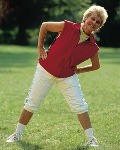Part Three: Keeping your Muscles Strong
So you’ve seen your physician and revamped your home. Finally, the most important step when it comes to fall prevention is to make sure you use it, don’t lose it.
 As we age, our bodies change: we experience loss of muscle and bone strength. In many instances simple activities such as walking up a few stairs or getting out of a vehicle become difficult, getting in or out of a bathtub can have a disastrous outcome.
As we age, our bodies change: we experience loss of muscle and bone strength. In many instances simple activities such as walking up a few stairs or getting out of a vehicle become difficult, getting in or out of a bathtub can have a disastrous outcome.
Our muscles and bones respond to the stresses that we put on them with our activities of daily living. As our lives become less vigorous our muscles and bones lose strength. The best way to overcome this is to keep our leg muscles strong by performing some basic exercises each day.
If you are inactive for an extended period of time and then you challenge your muscles by trying to perform a task that you have not done regularly your muscles may not be there for you. For example, if your main activity for years has been walking, then one day you need to move more quickly to avoid traffic, your legs may not have the power you need to speed up and you may end up falling. This is where “Use it or Lose It” comes into play. If you do not regularly put a baseline of demands on your body, especially your lower body, then you become weaker. This is why falling is the biggest health risk for seniors.
Additionally, poor balance contributes to the risk of falling, and there are plenty of simple exercises you can complete to help reduce that risk.
If you’re wondering what kind of shape you’re in, there are a couple of tests you can give yourself. To test the strength of your legs, sit down in a chair. If you can’t get up without using your hands, you are at a greater risk of falling. To test your balance, stand next to a counter you can easily grab onto. See how long you can stand on one foot without touching the counter for balance. If you can’t stand on one foot for 10 seconds, you have an increased risk of falling.
The good news is, there are plenty of exercises you can do to strengthen your lower body and improve your balance. Weight training at the gym will strengthen your legs, and yoga and tai chi are great for balance. Here are some other exercises you can do from home; try to complete them every day for the best results.
Hamstring Curls
Hold on to a sturdy chair or grab bar. Stand up tall
with your eyes forward. Keeping your knees shoulder width apart, bend one knee so that your heel comes up towards your back. If this is difficult, only lift your foot up as high as you are comfortable with. Start with a few repetitions and progress to 10 repetitions three times a day.
Step-ups
Stand facing a step or low bench. Lift one leg up onto the step and, while holding that position, lift your other leg up until you are standing on the step with your legs shoulder width apart. Lower your legs back down to the floor, first with the leading leg, then with the second. Start with a few repetitions and progress to ten repetitions three times per day.
Heel-to-Toe Walking
While holding onto a counter or rail for balance, walk while placing the heel of one foot directly in front of the toe of the other. As you become more advanced, you can do this exercise while just gently touching the counter.
Leg Extensions
While sitting up straight in a supportive chair, slowly straighten out your leg and lower it back down. Work towards holding your leg out for 10 seconds while breathing normally. Start with a few repetitions and progress to 10 repetitions three times per day.
While a fear of falling is common among older adults, it doesn’t have to be debilitating. By keeping up with your doctor’s appointments, paying close attention to your environment and keeping your lower body strong, you can continue to have an active and fulfilling life well into your retirement years.
